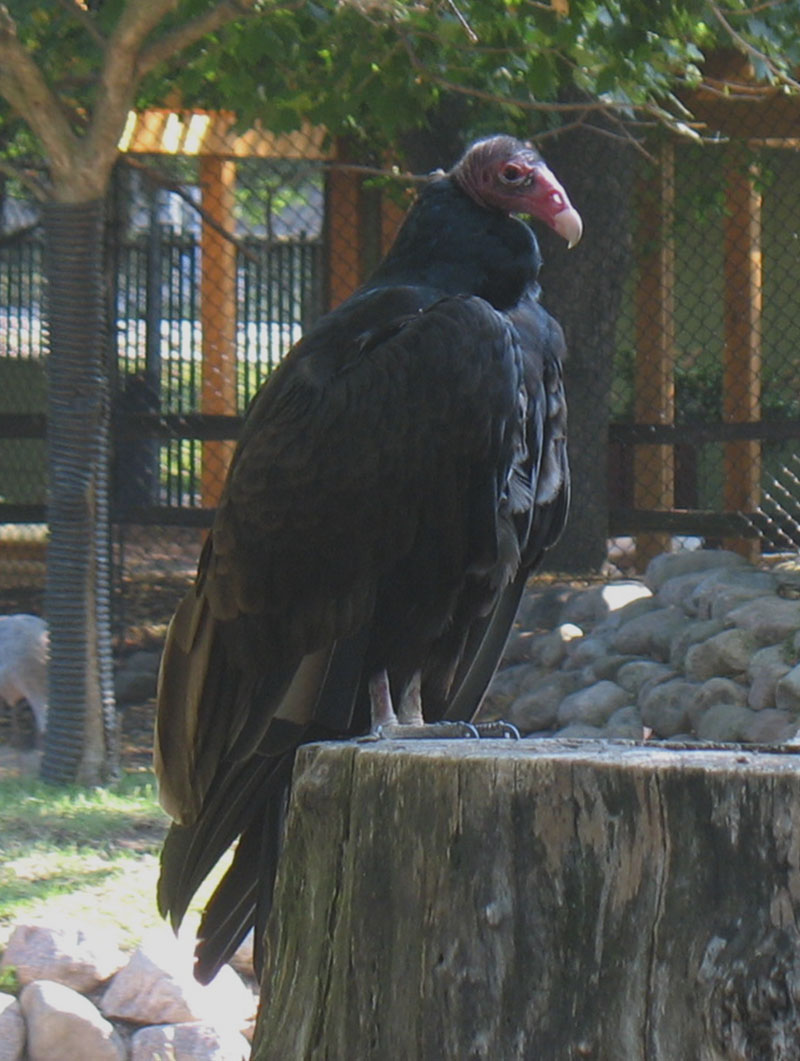Photo by Kmiecik Imagery
Turkey vulture
Cathartes aura
Description:
A turkey vulture is a large bird with black feathers. The undersides of its flight feathers are silver or white in color, and can be seen only when the bird is flying. As its name suggests, this bird has a bald head that resembles that of a turkey. Young turkey vultures have darker-colored heads that change to a lighter red color as the birds get older.
Size:
Turkey vultures average 25 inches (63.5 cm) in length, with a wingspan of up to 6 feet (1.8 m). They can weigh as much as 8 pounds (3.6 kg).
Adaptations:
- Their keen senses of both smell and sight help turkey vultures to locate the rotting meat that they consume.
- Although they appear awkward when walking on the ground, turkey vultures are quite graceful in the air. They have the ability to soar for long periods of time while expending very little energy.
- A vulture’s naked head is an adaptation which keeps the bird healthy. Because the vulture often has to put its head into a carcass to obtain food, feathers on the head would retain unwanted food and bacteria. Turkey vultures also urinate on their legs to kill any bacteria they pick up by standing on a carcass.
- Turkey vultures have a strong acid in their stomach that helps to kill the bacteria in the dead food they eat. This stomach acid can kill many serious diseases such as anthrax and influenza.
Diet:
Turkey vultures are scavengers, exclusively eating carrion (dead animals). At Cosley Zoo, the turkey vultures are fed fish, rats and quail.
Reproduction:
Turkey vultures nest between March and June when the weather is warm. They may nest on the ground or in a tree trunk. Turkey vultures do not spend much time making nests and often find areas of broken sticks or grasses in which to lay their eggs. Females lay only two eggs per nesting period. Both parents incubate the eggs for a total of 38-41 days.
After the chicks hatch, the parents feed them regurgitated food. Young turkey vultures leave the nest after 70-80 days.
Shelter and space needs:
Turkey vultures spend most of their time soaring over the land in search of the animal carcasses on which they feed. They roost in large trees or on buildings. These vultures mainly inhabit areas of deciduous forest with adjacent farmland or other open spaces.
Life expectancy:
Turkey vultures can live approximately 20 years in the wild or in human care.
Relationship with man:
Turkey vultures can be useful in discovering gas leaks. Vultures are attracted to the smell of rotten meat that is added to the gas. A group of vultures circling an area where a gas pipeline runs can be an indicator that there is a leak. Turkey vultures are also useful for removing dead animal carcasses before they pose a health risk to humans or other animals.
Fun Facts:
- The turkey vulture is one of the most efficient gliding birds. By searching out pockets of air that will keep it aloft, the vulture can soar for hours without flapping its wings!
- The turkey vulture’s main defense is vomiting. If disturbed, it will throw up a foul-smelling substance that deters many predators.
- The turkey vulture is one of the only birds on this continent that has a sense of smell.
- Because the turkey vulture does not kill in order to obtain food, its feet are not as strong as those of other birds of prey, which use their feet to grasp their food. Instead, the feet are rather weak appendages which are used primarily for grasping.






